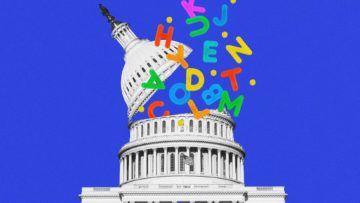Matteo Wong in The Atlantic:
 Judging by the titles of bills they propose, members of Congress occupy a space between used-car salesperson and poet. Over the past two years, lawmakers in the 117th Congress have introduced the DAYLIGHT Act (Daylight All Year Leads to Ideal Gains in Happiness and Temperament), the ZOMBIE Act (Zeroing Out Money for Buying Influence after Elections), the CROOK Act (Countering Russian and Other Overseas Kleptocracy), and the GIVE MILK Act (Giving Increased Variety to Ensure Milk Into the Lives of Kids). Some acronym names are so long that I can summarize the bill’s message in fewer letters: the CONFUCIUS Act (anti-China), the SPECIAL RELATIONSHIP Act (pro-U.K.), the CONSCIENCE Act (anti-vax).
Judging by the titles of bills they propose, members of Congress occupy a space between used-car salesperson and poet. Over the past two years, lawmakers in the 117th Congress have introduced the DAYLIGHT Act (Daylight All Year Leads to Ideal Gains in Happiness and Temperament), the ZOMBIE Act (Zeroing Out Money for Buying Influence after Elections), the CROOK Act (Countering Russian and Other Overseas Kleptocracy), and the GIVE MILK Act (Giving Increased Variety to Ensure Milk Into the Lives of Kids). Some acronym names are so long that I can summarize the bill’s message in fewer letters: the CONFUCIUS Act (anti-China), the SPECIAL RELATIONSHIP Act (pro-U.K.), the CONSCIENCE Act (anti-vax).
These reverse-engineered acronyms, or “backronyms,” are inescapable on Capitol Hill. Two of the biggest laws of the past few years were the CARES Act, for pandemic relief, and the CHIPS for America Act, for semiconductor manufacturing. Since early 2021, members of Congress have introduced two separate AMIGOS Acts, two PROTECT Florida Acts, and four SHIELD Acts. These naming devices can seem silly and contrived, especially when compared with the general soberness of Washington policy making. Yet congressional backronyms have been on the rise for years: I wrote a computer program to check legislation titles for acronyms that spell out complete words, and found that roughly 10 percent of bills and resolutions introduced over the past two years have had backronym names—up from about one in 20 a decade ago and less than 1 percent in the late 1990s. The proportion has risen with every Congress since at least 2001.
If that trend holds, the next Congress, elected this week, will be the most backronym heavy yet. So how did the acronym come to infiltrate American politics?
More here.
